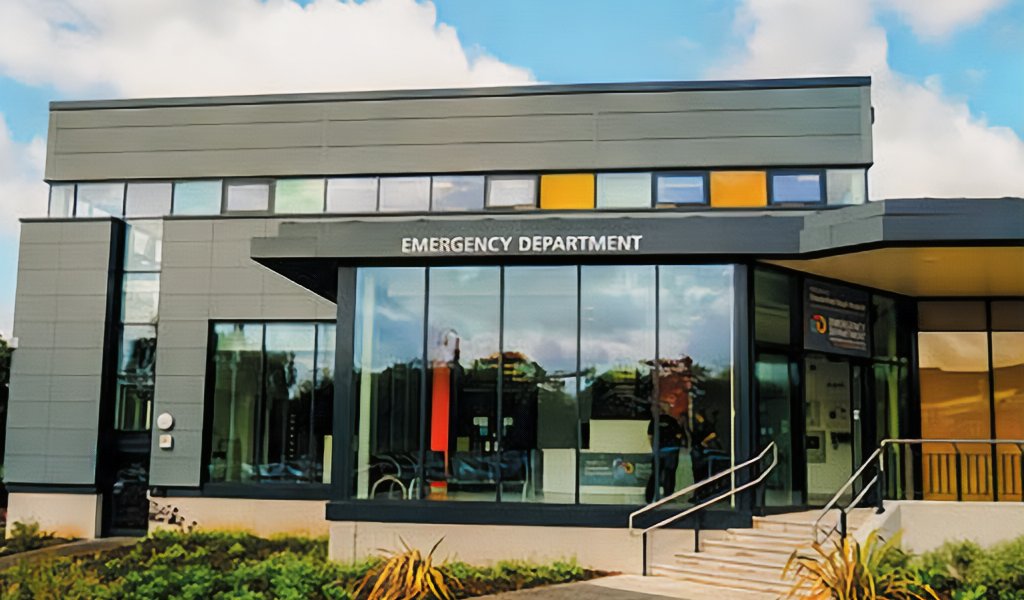It might be hard to believe, but the ‘new’ Chesterfield Royal Hospital at Calow has been serving us all for 40 years now. The hospital have provided this copy about those 40 years – and a little bit further back!
CHESTERFIELD Royal Hospital has come a long way in the last 40 years – well, 2.0 miles, to be precise.
On Sunday, April 29, 1984, the hospital moved from its small and – by today’s standards – cramped buildings in the town centre, to Calow. The hospital had humble origins, beginning life as a dispensary in a small house in St Mary’s Gate in 1854 before the foundation stone for the Holywell Cross site was laid by the Marquis of Hartington on the site of Durrant Hall in 1859. Once opened, that facility was known as the Chesterfield and North Derbyshire Hospital and Dispensary.
Sometime after the end of World War One, King George V permitted the name ‘Royal’ to be used, and the annual report of 1919 was the first time that the title, ‘Chesterfield and North Derbyshire Royal Hospital’, was used in a public document.
Having entered the ‘Emergency Hospital Scheme’ as part of the war effort on 1939, it began life as an NHS hospital in 1948. As healthcare needs grew, so did the hospital and a site which would support the healthcare needs of the town in a more appropriate and bigger setting was sought.
The construction of a motorway led to the identification of a site at Calow and in 1976 the green light was given for the construction of the new hospital which then opened in April 1984 and the rest, as they say, is history.
For comparison – it is worth noting that, in 1943, records show that the hospital had an annual budget of £80,668 – compare that with the budget the hospital held for the year ending in April 2024, which was a cool £361 million!
The total number of staff numbered 128 in 1944, with 5,000 now providing care to the local community.
In 1943, the breakdown of staff wages showed that nursing colleagues cost the board £10,477 – with medical colleagues earning a combined total of £7,492. Nowadays the starting salary for a newly-graduated nurse totals around £28,000.
At the old site, 5,600 inpatients were treated in 1944 – nearly 75,000 were treated in the year ending April 2023 at Calow.
There are still staff at the hospital who recall the move to the new site, the boxes of records brought up manually in the back of a Morris Marina, and the scanning equipment loaded into the back of transit vans, in marked difference to the military operation to winch the state-of-the-art recent MRI scanners in on a recent Sunday morning.
Ian Fretwell, a colleague at the old Royal and now a Governor at Calow, recalls: ”Whereas the old Royal had two main theatres, an ENT/Ophthalmic theatre and a theatre in A&E, the new hospital offered 12 theatres, theatre recovery, pre-theatre reception and much larger ITU. We only had three ITU beds and one additional ventilator kept outside the old ITU.”
The move went smoothly on the day – with patients needing discharge transferred ‘before the move’ meaning that only a few patients were through the doors on the first day, but staff recall the new feeling of the hospital – ‘like the Ritz’ – and the opportunities for food and breaks in a brand-new environment which catered for staff comfort and relief. Trevor Bembridge had the honour of being the first patient to be transferred in from the old hospital and was invited back for the 25th anniversary in 2009, where he cut the cake to celebrate the silver anniversary.
The hospital is not just Royal by name but has a proud and long-standing relationship with the Royal family who have frequently visited as the site grows.
Excitement built a year after opening when Queen Elizabeth II officially opened the site on March 15, 1985. Accompanied by Robert Robinson, Trust chair, Her Majesty toured the site, meeting clinicians and patients, nurses having been lent caps and capes for the day so that they could form the guard of honour. The stone plaque that she unveiled to mark the occasion is still on site and can be found in the corridor just adjacent to the main entrance.
This set the theme – with the hospital receiving ‘Royal at the Royal’ visits in subsequent years, with the Princess Royal coming back twice, most notably in July 2023 and Camilla, now the Queen, opening some of our wards. Her husband, now King Charles III but in those days the Prince of Wales, had visited in 1999 while The Duchess of Edinburgh, formerly the Countess of Wessex, came to the Royal where she toured the Scarsdale birth centre in 2010.
It hasn’t all been good news though – on the evening of June 25, 2011, a fire broke out which completely destroyed the main entrance, and badly affected the A&E and fracture clinics. There were no casualties, through the fire took several hours to get under control and resulted in the diversion of some services throughout the night.
The cause of the fire later became known – an electrical fault in a freezer in a shop had spread but had been contained by elements of the construction; and clinics and services were rerouted as soon as possible. The main entrance reopened on May 8 the following year.
The spring of 2020 brought challenges of a different kind as a virus we now know to be COVID-19 spread throughout the world. Chesterfield Royal Hospital, as with every healthcare organisation in the world, faced an unprecedented and unknown condition which changed life as we all knew it and caused the rethinking of healthcare priorities and schedules for over two years. As an example, in January 2021 Chesterfield Royal released a statement saying they were caring for the highest number of COVID patients so far in the pandemic, with 169 COVID patients, 16 of whom were in ITU. For some people, COVID is a thing consigned to history. But for many NHS workers, COVID is something they live with every day. During the pandemic, Chesterfield Royal Hospital colleagues rose to the challenge, often working above and beyond and the stories they tell about that time are humbling.
Post-pandemic, the landscape of healthcare in the NHS is forever changed. With that in mind Chesterfield Royal Hospital began an ambitious but much needed campaign to care for the carers and, with local support, from the community who fundraised, and with support from NHS Charities Together and Westfield Health, secured funding for a £2-million bespoke, purpose-built Health & Wellbeing hub which contains not only a state of the art gym with trained personal trainers and Health Improvement Advisors, but also a suite of counselling rooms offering colleagues a chance to talk, debrief and decompress with their team, or with the help and support of partners such as Ashgate Hospice.
“the £27 million Urgent and Emergency Care development opened, with 1,000 patients.”
This building was just one part of the developments which have seen the hospital and the site begin to build for the future. Last year, in June 2023, the £27 million Urgent and Emergency Care development opened, with 1,000 patients having come through its doors by the time the ‘official opening’ by the Princess Royal took place on Wednesday, July 12. A specialist Paediatric Assessment Unit – a place where younger patients can be monitored and treated without being admitted onto the paediatric ward – was also opened last June.
As the population of Chesterfield and North Derbyshire has expanded so have their services – annual funding comes from a central pot and, as with all organisations, there is a need to live within their means. With an annual budget this year of over £300 million – and a population of 400,000 to care for the hospital must continue to prioritise and plan.
The mission of exceptional care carried out by exceptional people keeps the patient and colleagues at the centre of everything – and in the hospitals most recent staff survey the hospital was in the top five percent of Trusts – with 71.7% of colleagues saying they would recommend the hospital as a place to work. 72.7% of staff also said that if a loved one needed treatment they would recommend Chesterfield Royal Hospital as a place to receive the treatment necessary.
The NHS prides itself on treating its patients from cradle to grave, and some of the 2,810 babies born within the community of Chesterfield this year will go on to reap the rewards of some of the ambition that the Trust has for the care of Chesterfield. A thriving workforce who work as part of an anchor institution, with 70% of the workforce living and working in Chesterfield themselves, and committed to serving not only the health but the wellbeing of colleagues and community alike the Trust is looking forward to driving improvements in patient care, with electronic patient records, a commitment to clinical research, and an ambition to ensure that the community of Chesterfield and North Derbyshire continue to receive the highest standard of care for many more years to come.
Editor’s Note: The team at the Royal welcome donations and fund-raising efforts to support them that mean they can go above and beyond – offering more than what might be possible through ‘normal NHS funding’. There is an ‘our charity’ section on the website: www.chesterfieldroyal.nhs.uk






